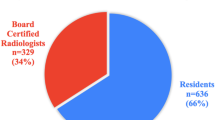Abstract
Objective
To document current postgraduate musculoskeletal training program (accredited and unaccredited) curricula and approaches to education.
Design and patients
Questionnaires were sent to all musculoskeletal training programs. Responses regarding radiology residency and fellowship program sizes, types of imaging and invasive procedures included, and other program parameters were solicited. Features of accredited and unaccredited programs were compared. Teaching approaches, including the use of web-based or distance learning were evaluated.
Results
Twenty-nine (73%) of 40 musculoskeletal programs responded to the questionnaire. Twenty-eight percent of programs were accredited and 72% unaccredited. Radiology residencies were also present at all responding institutions (the majority had a class size of 4–8/year). Residency programs in related specialties included pathology 96%, orthopedics and rheumatology 90%, oncology 83% and pain management 69%. The majority (93–100%) provided training in radiography, MRI and CT. Spine MRI was included in 69% of programs, ultrasonography in 62% and positron emission tomography in 24%. Arthrography and diagnostic and therapeutic injections (100%) were included in all programs. Other invasive procedures, including spine and radiofrequency ablation, were offered less frequently. Teaching approaches included conferences (100%), journal clubs (62%), multidisciplinary conferences (45–90%), web-based learning (30%) and distance learning (7%). Forty-one percent of programs offered off-site rotations.
Conclusions
The majority of musculoskeletal training programs prepared trainees for private or academic practice. There are inconsistencies that could be improved to better prepare trainees for careers in musculoskeletal imaging.

Similar content being viewed by others
References
AMA. Program requirements for residency education in musculoskeletal radiology (radiology-diagnostic). Graduate medical education directory. Chicago, Ill: American Medical Association, 2002–2003:351–352.
Resnick C, DeSmet A, Chen F, Kathol M, Kransdorf M, Steinbach L. Musculoskeletal radiology curriculum guide. The American Society of Skeletal Radiology. Acad Radiol 1999; 6:360–367.
Glauser SJ, Maynard CD. Residency and fellowship training in radiology: survey of all United States programs. Acad Radiol 1994; 1:158–163.
Smith WL. Sub-specialization. Acad Radiol 1995; 2:88–89.
Carreno JA, Morrison WB, Parker L, Schweitzer ME, Levin DC, Sunshine JH. Spinal injection procedures: volume, provider distribution and reimbursement in the US Medicare population from 1993 to 1999. Radiology 2002; 225:723–729.
Wright KC. The language of research: learning the lexicon. Acad Radiol 2002; 9:1194–1200.
Sonners AI. Value of a radiology research rotation: a medical student's perspective. Acad Radiol 2002; 9:805–807.
Bean CA. Fundamentals of clinical research for radiologists. AJR Am J Roentgenol 2002; 179:47–52.
Tello R, Davidson BD, Blickman JG. The virtual course: Delivery of live or recorded material over the Internet. AJR Am J Roentgenol 2000; 174:1519–1521.
Rosset A, Ratib O, Geissbuhler A, Vallei J-P. Integration of multimedia teaching and reference database in a PACS environment. RadioGraphics 2002; 22:1567–1577.
Mullins ME, Mehta A, Patel H, McLoud TC, Novelline RA. Impact of PACS on the education of radiology residents: the resident's perspective. Acad Radiol 2001; 8:67–73.
Angle JF, Gay SB, Hagspiel KD, Spinosa DJ, Leung DA, Matsumoto AH. Relative value of analog and digital teaching files. Acad Radiol 2002; 9:205–210.
Neiman HL. Practical business aspects of radiology. AJR Am J Roentgenol 2000; 174:1523–1528.
Gunderinan RB. Why is ethics needed in the radiology curriculum? Acad Radiol 2001; 8:82–85.
Author information
Authors and Affiliations
Corresponding author
Rights and permissions
About this article
Cite this article
Berquist, T.H., Bancroft, L.W., Kransdorf, M.J. et al. <p>Postgraduate musculoskeletal fellowship training in the United States: current trends and future direction. Skeletal Radiol 32, 337–342 (2003). https://doi.org/10.1007/s00256-003-0634-0
Received:
Revised:
Accepted:
Published:
Issue Date:
DOI: https://doi.org/10.1007/s00256-003-0634-0




